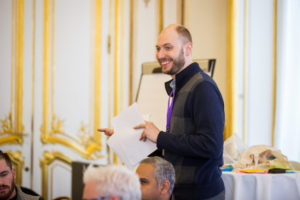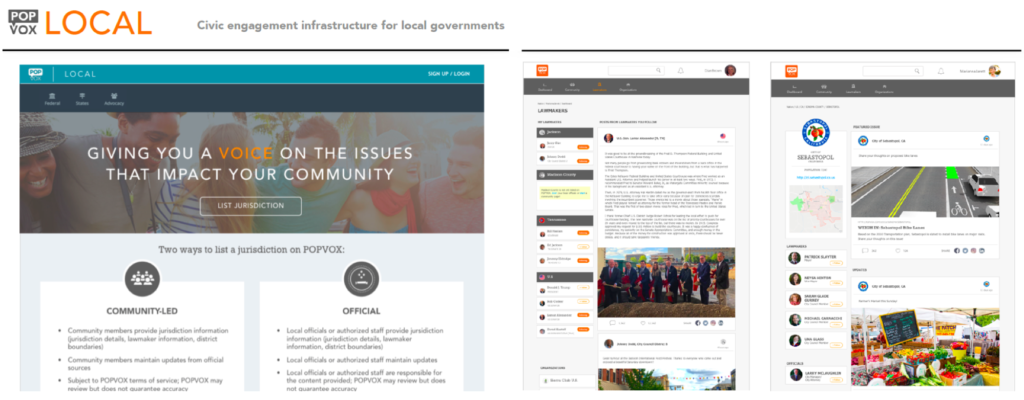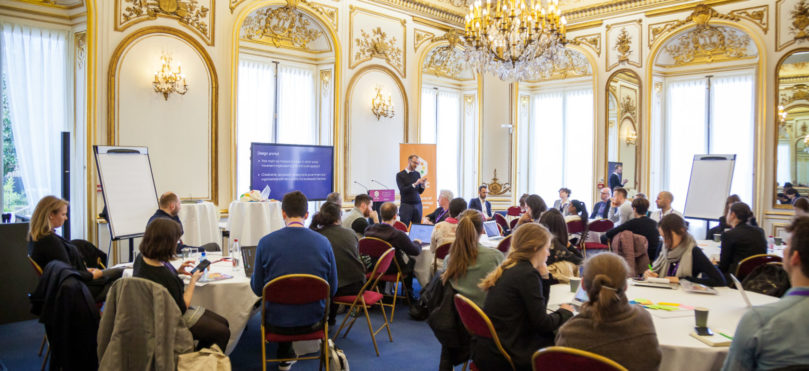by Alisa Zomer, Erhardt Graeff, and Kelly Zhang
Bringing together partners from the US (POPVOX) and South Africa (Grassroot), we tested a new format to co-develop metrics and civic technology in an iterative design process.
This year’s largest civic technology gathering of practitioners and researchers (#TICTeC) took a hard look at the state of civic technology (i.e. Are we now in the fourth wave? Is it a sea change movement or has civic tech lost its relevance?). Focusing on questions of measuring impact, our team, including Erhardt Graeff from Olin College and Alisa Zomer and Kelly Zhang from MIT GOV/LAB, put together a design sprint workshop with partners POPVOX (U.S) and Grassroot (South Africa). The aim of our session was to kick-start an iterative design process to integrate social impact metrics into platform design from the very beginning, not as afterthought.
What does this mean in practice?

As Erhardt discussed in recent work, impact for civic technology is often measured using basic descriptive data from the platform itself, including number of users, repeat users, time spent on the platform, etc.; however, these engagement metrics mostly fail to speak to the social impact goals at the heart of civic technology. In some cases, surveys are conducted where users rate their experiences on a platform, which can be helpful for troubleshooting user experience design problems. But answering the real question of social impact (i.e. has the platform changed outcomes, either beliefs or behavior) demands a different kind of metric.
In our workshop, we introduced an approach that starts by articulating what change you want to see—do you want to empower ordinary citizens to take a particular action (e.g., petition, protest, vote)? Or, do you want to see local government have a specific response (e.g., budget allocation, new legislation, improved service provision)?
Depending on the intended change, there is often relevant research to help in the design process. A wealth of research exists on what incentivizes or prevents citizens from engaging with their government, how to build strong grassroots movements, and also what barriers or opportunities present on the government side. Building on this knowledge, our goal is to bridge theory with design in a way that aligns with achieving and measuring social impact.
For POPVOX, a platform to improve dialogue between citizens and government in the US, they ask: How might we measure participants’ understanding of government processes, comfort engaging, and sense that their voice matters? One approach taken by Erhardt previously is to measure perceived political efficacy (or the belief that you can influence or affect political change) in his work with SeeClickFix. He adapted a number of oft-used national survey questions for internal and external political efficacy to examine the context of city residents requesting their local governments fix the things they care about, finding correlations between government responsiveness on the platform and active users’ perceptions that their local governments were listening to them.

Grassroot, which provides low-tech, low-cost tools for grassroots organizers working primarily with low income groups in South Africa, posed the following: How might we measure the ways in which social movement organizations grow and build capacity? Their main design constraints include a consistently unresponsive government and social movement organizations that have strong initial momentum but then steeply decline.

Dividing into small groups, we tackled these design prompts to come up with relevant and feasible metrics, explain why they matter, and what data would be needed to measure them.
Sprinting for impact
Design sprinting in 70 minutes is not for the faint of heart, but we forewarned participants and the end results were a good start to a longer process. For Grassroot, some of the suggestions included looking at leadership development within organizations over time, assessing media visibility as a proxy for reach outside the movement, and measuring interactions between organizers across multiple policy issues. For POPVOX, suggestions included design features that notified citizens when officials read comments in order to build in some measure or response and trust-building.
In the coming months, both teams plan to move these pilots forward, building on the outcomes of the TICTeC workshop.
Workshop descriptions and slides available online. For more information, contact the MIT GOV/LAB at mitgovlab@mit.edu or Erhardt Graeff at erhardt@erhardtgraeff.com.
All event photos from Brian David Films.
This report is cross-posted at the MIT GOV/LAB blog.
